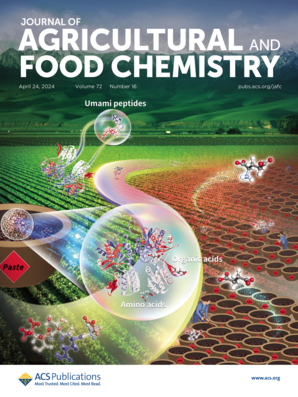Comprehensive Structural Characterization of Wheat Bran Lignin
IF 5.7
1区 农林科学
Q1 AGRICULTURE, MULTIDISCIPLINARY
引用次数: 0
Abstract
Wheat bran is a large volume sidestream of wheat flour production and is used in food and feed applications. Despite great advances in the characterization of the wheat bran hemicellulose component, thus far, only limited attention has been paid to wheat bran lignin. Here, we describe the comprehensive structural characterization of wheat bran lignin, facilitated by sequential enzymatic starch and protein removal, followed by mild γ-valerolactone organosolv extraction and extensive purification. Quantitative 13C-IS pyrolysis-GC-MS and HSQC NMR revealed that wheat bran lignin is enriched in syringyl subunits (S/G ∼ 0.9), as compared to wheat straw lignin (typical S/G ∼ 0.5), but surprisingly poor in p-coumarate incorporated (<1 per 100 aromatic rings), entirely free of tricin, and accordingly composed of typical β-O-4 aryl ether (84%), β-5 phenylcoumaran (7%), and β–β resinol (9%) interunit linkages. Moreover, and in line with the interunit linkage abundance (46 per 100 aromatic rings), alkaline SEC and 31P NMR, respectively, confirmed a macromolecular nature (Mw 6900 g/mol, Đ 5.9) and low phenolic hydroxyl content (1.6 mmol/g of lignin) of the wheat bran lignin structure. Our extensive characterization efforts contribute to the dedicated valorization of wheat bran lignin and support understanding potential physiological effects when incorporated into human and animal diets.

求助全文
约1分钟内获得全文
求助全文
来源期刊
CiteScore
9.90
自引率
8.20%
发文量
1375
审稿时长
2.3 months
期刊介绍:
The Journal of Agricultural and Food Chemistry publishes high-quality, cutting edge original research representing complete studies and research advances dealing with the chemistry and biochemistry of agriculture and food. The Journal also encourages papers with chemistry and/or biochemistry as a major component combined with biological/sensory/nutritional/toxicological evaluation related to agriculture and/or food.

 求助内容:
求助内容: 应助结果提醒方式:
应助结果提醒方式:


